The US takes leadership

It was not before the late 1940s after lessons of WWII submarine warfare were learned when the next in situ system was developed in the USA by A. W. Jacobsen. He worked for the Bristol Corporation in Waterbury, Connecticut, the manufacturer of famous mechanical bathythermographs (MBT), which were widely in use by US Navy oceanographers on the fleet of destroyers. The instrument was developed under subcontract with the Woods Hole Oceanographic Institution, where work was initiated by the great oceanographer Allyn Vine, who worked then on improvements of MBTs for use on submarines and later moved to the development of scientific submersibles (legendary SV”Alvin” was named on his honour).
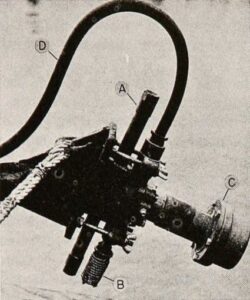
resistance thermometer; C- depth/pressure element; D- cable
The instrument consisted of a measuring unit connected to a computing and recording assembly by an appropriate length of multiple-lead cable. Its use was limited to 400 meters. The measuring unit responds to the temperature and conductivity of the seawater and to the pressure (depth) at which these variables are being measured. In the computing and recording assembly, the salinity was automatically computed from the conductivity and temperature signals and was recorded together with the temperature and the depth on a moving chart.
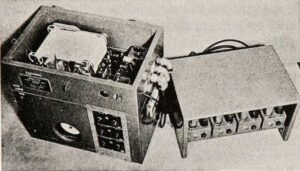
The instrument operated on a 110-volt 60-cycle current. The salinity was determined over the range 20‰ to 40‰, generally with an error not exceeding ±0.25‰, and the temperatures from -2°C to 32°C are recorded with error of about ±0.2°C.
Several instruments have been built and tested at WHOI. Field use of the instrument falled into two categories:
- the determination of the horizontal distribution of salinity and temperature near the surface by continuous measurement from a moving vessel
- investigations of the vertical distribution of these variables during which the vessel must be hove to.
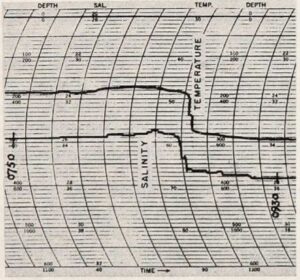
For vertical measurements, two methods have been used. In shallow, sheltered waters with sharp gradients, the measuring unit is
lowered stepwise on a measured cable and provision is made for
flushing of the conductivity cell by a pump. In deeper water the
depth recording mechanism is employed and the measuring unit is
lowered continuously.
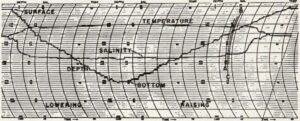
In either case, the instrument has proved useful, since it gives a continuous record of the variables and because the observer is immediately informed of existing conditions, thus permitting the survey program to be adapted to the best advantage at the time. Three of the instruments have each had several hundred hours of operation at sea. Not much other information is available about this development but, despite being very simple and having low accuracy, this system opened the way for new measurement methods in Oceanography.
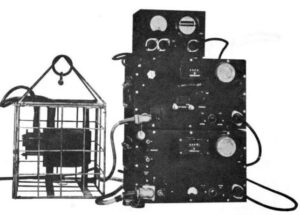
The Chesapeake Bay Institute of John Hopkins University had spent considerable effort in the development of an in situ temperature-salinity measuring device. The most improved version was the induction conductivity-temperature indicator (ICTI). Early developments included the conductivity-temperature indicator (CTI) (Schiemer and Pritchard, 1957) and the induction conductivity indicator (ICI) (Esterson, 1957). The ICTI consisted of two self-balancing digital direct readout indicators and used to make conductivity and temperature measurements. The conductivity is sensed by two exciting and signal transformers. The temperature was sensed by a thermistor bead. The ranges of measurement were: salinity 0‰ to 35‰, and temperature -2°C to 32°C. The accuracy of ICTI did not exceed ±0.02°C for temperature and ±0.37‰ for computed salinity. The operating depth was approximately 70m, within which the effect of pressure on the conductivity sensing elements wasn’t significant.






 Visit Today : 40
Visit Today : 40 Visit Yesterday : 164
Visit Yesterday : 164 This Month : 2036
This Month : 2036 Total Visit : 258448
Total Visit : 258448 Hits Today : 64
Hits Today : 64 Total Hits : 658144
Total Hits : 658144 Who's Online : 1
Who's Online : 1